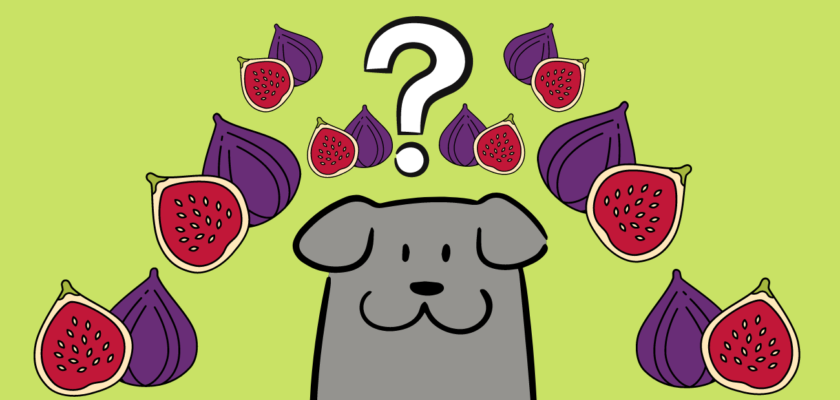Can dogs eat figs? They provide lots of nutrients, but in large quantities they may cause more harm than good. Today, we want to discuss the pros and cons of feeding your dog figs. Let’s get started!
Key Takeaways
- Dogs can eat figs ✔️
- A lot of figs can cause diarrhea in dogs ❌
- You should keep your dog away from fig newtons ❌
- You can use pieces of figs as dog treats ✔️
- A few figs per week are OK ✔️
Can Dogs Eat Figs?
So, can dogs eat figs? Yes! In fact, they offer plenty of benefits.
- Figs provide dietary fiber, essential for maintaining a healthy digestive system in dogs.
- Potassium, a vital element for dogs, aids in managing fluid balance and promoting nerve and muscle function.
- B-complex vitamins found in figs help sustain your dog’s energy levels and contribute to overall well-being.
- Magnesium, another nutrient in figs, supports muscle and nerve function as well as bone health.
- Figs contain the enzyme ficin, which assists in protein digestion.

Dry Figs or Fresh Figs?
In general, dried figs are better for dogs than fresh ones. Dried figs are rich in nutrients and antioxidants, whereas fresh figs contain high amounts of sugar and moisture, potentially causing digestive issues.
Can Dogs Eat Fig Newtons?
Fig newtons are cookies made with figs, flour, sugar, water, eggs, baking powder, and vanilla extract. Fig newtons also contain the artificial sweetener xylitol, which is toxic to dogs. Dog owners should avoid these cookies at all costs.
Can Dogs Eat Fig Leaves?
Fig leaves contain a compound called psoralen, which is poisonous to dogs. It can cause gastrointestinal problems and is also a reproductive toxin, meaning it can harm pregnant dogs or dogs that are nursing puppies. We also don’t recommend growing fig plants in your garden.
Can Dogs Eat the Skin of Fig?
Can dogs eat fig skin? Yes. It’s a good source of fiber and contains antioxidants that can help protect your pup from cell damage. Additionally, the skin of figs is a good source of vitamin B-complex vitamins.

How Many Figs Are Bad for Dogs?
In general, a fig or two a week won’t cause fig poisoning. But if your dog is allergic to figs, even a small bite could cause a reaction. So, always start with a small amount, monitor for symptoms, and then increase the amount of figs.
The Risks of Feeding Your Dog Figs
Now let’s take a look at the risks of feeding your dog figs. Let’s examine the potential dangers of giving figs to your dog.
- Figs are high in sugar, and consuming excessive amounts can be detrimental to dogs.
- Moreover, overfeeding figs may lead to diarrhea and other gastrointestinal issues like vomiting.
- Figs contain small amounts of xylitol, which, despite being a natural sugar, is not safe for dogs.
Editor’s Note 🐕
The risks and the benefits boil down to one rule: moderation.
Now You Have It All Fig-ured Out
So, can dogs eat figs? Overall, the pros of feeding your dog figs outweigh the cons. However, it’s important to always check the ingredients label of any food products you give your dog and to speak with your veterinarian if you have any questions. Figs can be a healthy addition to your pup’s diet – as long as they’re fed in moderation, and you take into account their individual health needs.

My Dog Ate a Fig – A Cautionary Tale
Once upon a time, in a quaint little town, lived a devoted dog owner named Sarah and her faithful companion, a golden retriever named Max. They shared a cozy home with a beautiful backyard garden filled with various fruits, vegetables, and flowers.
One sunny afternoon, while Sarah was tending to her garden, she noticed that her fig tree had begun to bear fruit. She was excited about the delicious figs and decided to pick some to enjoy later. After harvesting a few, she left them in a basket on the kitchen counter and went back outside to continue gardening.
Max, who was lounging in the living room, caught a whiff of the sweet aroma from the figs. His curiosity piqued, and he couldn’t resist the temptation. He jumped onto the counter and gobbled down the figs, one by one, until the basket was empty.
A couple of hours later, Sarah came back inside, only to find the empty basket and a guilty-looking Max. Confused and concerned, she quickly searched the internet to find out if figs were safe for dogs. She learned that while they could be harmless in small quantities, there were potential risks, including allergic reactions.
Soon, Max began to show signs of distress. He started scratching incessantly, and hives appeared all over his body. Sarah knew it was time to act. She grabbed her keys and rushed Max to the nearest veterinary clinic.
Upon arrival, the veterinarian assessed Max’s condition and confirmed he was experiencing an allergic reaction. The vet administered medication to counteract the reaction and monitored Max closely. After several hours, Max’s condition began to improve, and he was soon back to his playful, energetic self.
Sarah was relieved but learned a valuable lesson that day. From then on, she made sure to keep all fruits and potentially harmful foods out of Max’s reach. She even installed a child-proof lock on her pantry to prevent any future mishaps.
Similar Posts:
- Can Dogs Eat Dates? Weighing the Benefits and Risks of Dates for Dogs
- Can Dogs Eat Crab? Everything You Need to Know
- Can Dogs Eat Asparagus?
- Can Dogs Eat Prunes? Are Dried Plums Safe For Dogs to Eat?
- Can Dogs Eat Persimmons? Are the Seeds or Pits Bad for Dogs?
- Can Dogs Eat Cantaloupe? Are These Melons Safe for Dogs?
- Can Dogs Eat Avocado? Is This Human Food Safe for Dogs?
- Can Dogs Eat Kiwi Safely? The Truth About Kiwis and Dogs

